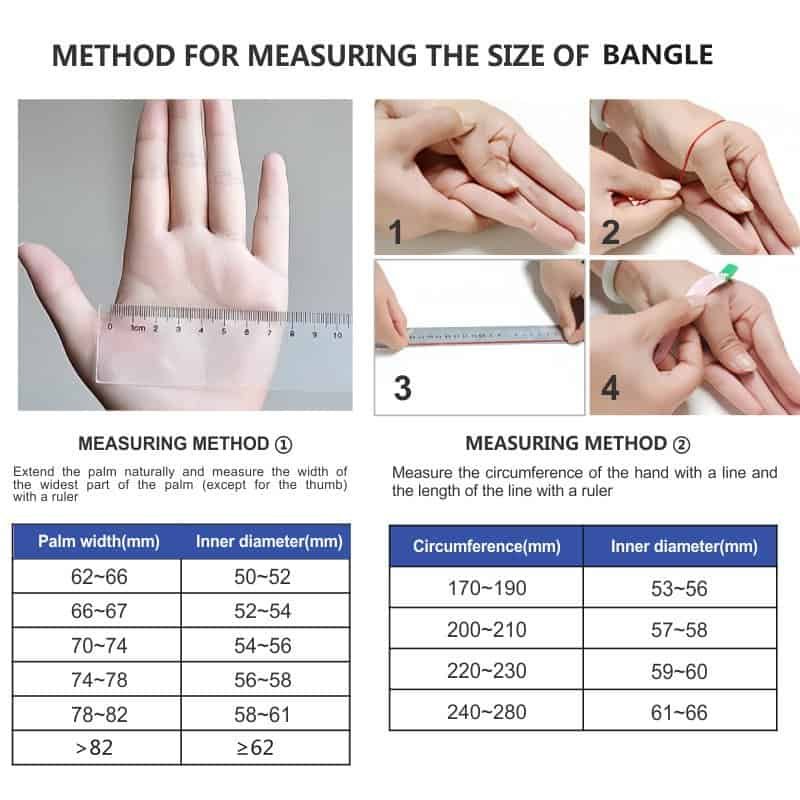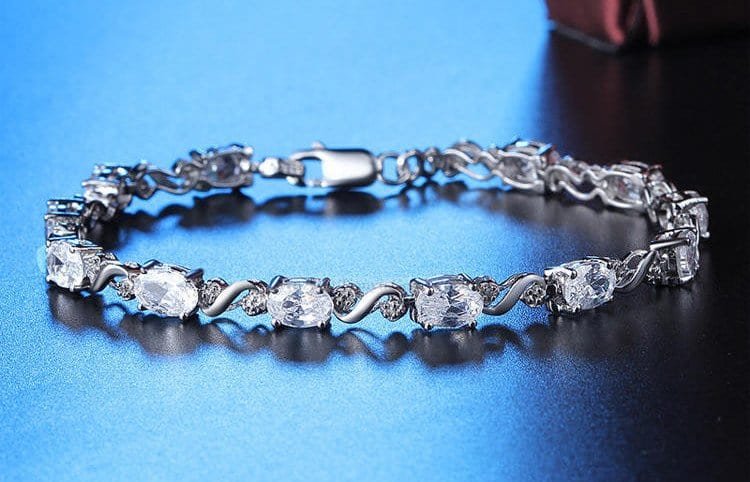Are you tired of wearing bracelets that are too tight or too loose? Finding the perfect fit can be a challenge, but fear not! In this comprehensive guide, we will take you through the ins and outs of bracelet sizing.
Getting the right fit is crucial for both comfort and style. A bracelet that is too tight can be uncomfortable and restrict blood flow, while one that is too loose may slip off your wrist or feel cumbersome. That’s why it’s important to understand the different sizing options available and how to measure your wrist accurately.
Whether you’re shopping for a charm bracelet, a beaded bracelet, or a delicate gold chain, our article will cover everything you need to know to achieve the perfect fit. From measuring your wrist circumference to understanding the various size options, we will provide you with all the necessary information to make an informed decision.
Don’t settle for ill-fitting bracelets anymore. Read on to discover the insider tips and tricks for finding the perfect fit and start rocking your wristwear with confidence!
Why Bracelet Sizing is Important
Bracelet sizing is often overlooked, but it plays a crucial role in ensuring that your bracelet fits comfortably and looks stylish. A well-fitting bracelet can enhance your overall appearance and complement your outfit, while a poorly fitting one can be distracting and uncomfortable.
One of the main reasons why bracelet sizing is important is for comfort. Wearing a bracelet that is too tight can cause discomfort and restrict blood flow, leading to numbness and tingling. On the other hand, a bracelet that is too loose may slide up and down your wrist, causing irritation and annoyance.
Another reason why bracelet sizing is important is for aesthetics. A perfectly fitted bracelet will sit nicely on your wrist, accentuating your style and adding a touch of elegance to your look. It will not overwhelm your wrist or get lost among your other accessories.
How to Measure Your Wrist For a Bracelet

Before purchasing a bracelet, it’s important to measure your wrist accurately to ensure a proper fit. Here’s a step-by-step guide on how to measure your wrist:
1. Start by wrapping a flexible measuring tape or a piece of string around your wrist, just below the wrist bone. Make sure it’s snug but not too tight.
2. Mark the point where the tape or string meets and measure the length with a ruler. This measurement will give you the circumference of your wrist.
3. Alternatively, if you don’t have a measuring tape or string, you can use a strip of paper. Wrap it around your wrist, mark the point of overlap, and measure the length with a ruler.

Once you have your wrist circumference measurement, you can use it as a reference to find the right bracelet size. Keep in mind that different bracelet types may require different sizing methods, so it’s important to understand the options available.
Understanding Different Bracelet Sizing Methods – Standard, Adjustable, and Custom
When it comes to bracelet sizing, there are three main methods: standard, adjustable, and custom. Understanding these methods will help you choose the right bracelet size for your needs.
1. Standard sizing: This is the most common sizing method used by jewelry manufacturers. Bracelets are typically available in standard sizes such as small, medium, and large. These sizes are based on average wrist measurements and may vary slightly between brands. If your wrist falls within the average range, a standard-sized bracelet should fit you well. However, if your wrist size is smaller or larger than average, you may need to explore other sizing options.
2. Adjustable sizing: Adjustable bracelets are designed to fit a range of wrist sizes. They usually feature a sliding mechanism or a chain extender that allows you to adjust the length of the bracelet to your liking. This type of bracelet is a great option if you prefer flexibility and versatility. Adjustable bracelets can be worn by multiple people or adjusted to fit different wrist sizes throughout the day.
3. Custom sizing: If you have a unique wrist size or prefer a perfect fit, custom-sized bracelets are the way to go. With custom sizing, the bracelet is made specifically to match your wrist measurements. This option is ideal if you have a smaller or larger than average wrist, or if you want a bracelet that fits snugly without any extra slack. Keep in mind that custom-sized bracelets may be more expensive and take longer to produce.
Choosing The Right Bracelet Size For Different Bracelet Types – Bangles, Cuffs, Chain Bracelets, etc.

Different bracelet types require different sizing considerations. Here’s a breakdown of how to choose the right bracelet size for popular bracelet types:
1. Bangles: Bangles are rigid bracelets that slip over your hand and rest on your wrist. To find the right bangle size, measure the circumference of your hand at its widest point (usually around the knuckles). Add about 1 inch to this measurement to allow for a comfortable fit. If you prefer a looser fit, you can add more than 1 inch.
2. Cuffs: Cuff bracelets are open-ended and can be adjusted to fit your wrist. To find the right cuff size, measure your wrist circumference and choose a cuff that is slightly smaller or larger than your measurement, depending on how snug or loose you want it to be. Keep in mind that cuffs with intricate designs or gemstones may be less adjustable, so it’s important to choose the right size from the start.
3. Chain bracelets: Chain bracelets come in various styles, including delicate chains, charm bracelets, and link bracelets. To find the right size for a chain bracelet, measure your wrist circumference and add about 0.5 to 1 inch for a comfortable fit. This extra length will allow the bracelet to drape nicely around your wrist without feeling too tight.
Factors to Consider For a Comfortable Fit – Bracelet Style, Materials, and Personal Preference
In addition to wrist size, there are several factors to consider for a comfortable bracelet fit. These factors include bracelet style, materials, and personal preference.
1. Bracelet style: Different bracelet styles may fit differently on your wrist. For example, a wide bangle may feel tighter than a delicate chain bracelet of the same size. Consider the style of the bracelet and how it will sit on your wrist when choosing the right size.
2. Materials: Bracelets made from different materials may have varying levels of flexibility and stretch. For example, a metal bangle may not have any give, while a beaded bracelet may have some stretch. Keep this in mind when choosing the right bracelet size.
3. Personal preference: Some people prefer a snug fit, while others like a looser fit. Consider your personal preference and how you want the bracelet to feel on your wrist. If you’re unsure, it’s always a good idea to try on different sizes and styles to see what works best for you.
Tips For Finding The Perfect Bracelet Size Online
Shopping for bracelets online can be convenient, but it can also be challenging to find the perfect size without trying them on. Here are some tips to help you find the right bracelet size when shopping online:
1. Check the measurements: Pay close attention to the product description and look for the bracelet’s measurements. Compare these measurements to your own wrist circumference to get an idea of how the bracelet will fit.
2. Read customer reviews: Customer reviews can provide valuable insights into the fit and sizing of a bracelet. Look for reviews from customers with similar wrist sizes to get an idea of how the bracelet may fit you.
3. Look for adjustable options: If you’re unsure about the exact size, consider choosing an adjustable bracelet. Adjustable bracelets can provide flexibility and allow you to fine-tune the fit to your liking.
4. Check the return policy: It’s always a good idea to check the return policy before purchasing a bracelet online. This way, if the bracelet doesn’t fit as expected, you can easily return or exchange it for the right size.
Adjusting Bracelet Size – Adding or Removing Links, Using Extenders, or Resizing With a Jeweler
If you already have a bracelet but it doesn’t fit quite right, there are several ways to adjust the size. Here are some common methods:
1. Adding or removing links: Many bracelets, especially chain bracelets, can be adjusted by adding or removing links. If the bracelet is too tight, you can have a jeweler add extra links. If it’s too loose, links can be removed to shorten the length.
2. Using extenders: Extenders are small pieces of chain or additional links that can be added to a bracelet to increase its length. This is a great option if you have a bracelet that is slightly too short but fits well otherwise.
3. Resizing with a jeweler: If your bracelet requires significant resizing or adjustments, it’s best to consult a professional jeweler. They can resize the bracelet to your specifications and ensure a perfect fit.
Common Bracelet Sizing Mistakes to Avoid
When it comes to bracelet sizing, there are some common mistakes that you should avoid. These mistakes can result in an ill-fitting bracelet that is uncomfortable or doesn’t look as good as it could. Here are a few to keep in mind:
1. Guessing your size: Guessing your bracelet size without measuring your wrist accurately is a recipe for disappointment. Always take the time to measure your wrist and refer to size charts or guides before purchasing a bracelet.
2. Ignoring bracelet style: Different bracelet styles may require different sizing considerations. Don’t assume that the same size will work for all bracelets. Take into account the style and design of the bracelet when choosing the right size.
3. Forgetting about flexibility: Some bracelets, such as beaded bracelets, may have some flexibility or stretch. Keep this in mind when choosing the right size. A slightly smaller size may be more comfortable if the bracelet has some give.
Frequently Asked Questions About Bracelet Sizing
Q: Can I wear multiple bracelets together? How should I size them?
A: Absolutely! Wearing multiple bracelets together can create a layered and stylish look. When sizing multiple bracelets, consider the overall fit and balance. You can choose bracelets in different sizes to create variation, or opt for a standard size that fits your largest wrist measurement.
Q: How tight should a bracelet be?
A: A bracelet should be snug enough to stay in place but not too tight that it restricts blood flow or causes discomfort. It should be able to move slightly on your wrist without sliding up and down.
Q: Can I adjust the size of a bracelet myself at home?
A: It depends on the type of bracelet and the adjustments needed. Simple adjustments like adding or removing links may be possible to do at home with the right tools. However, complex adjustments or resizing should be done by a professional jeweler.
Q: What if I’m between standard sizes?
A: If you find yourself between standard sizes, it’s usually best to go for the larger size. You can always use extenders or have a jeweler remove links to adjust the size later if needed.
Conclusion
Finding the right bracelet size is essential for both comfort and style. By understanding the different sizing methods, measuring your wrist accurately, and considering factors such as bracelet style and materials, you can ensure a perfect fit every time. Whether you prefer standard-sized bracelets, adjustable options, or custom-sized pieces, there’s a bracelet out there that will adorn your wrist with elegance and confidence. Don’t settle for ill-fitting bracelets anymore – use the tips and tricks in this guide to find the perfect fit and rock your wristwear with style!









